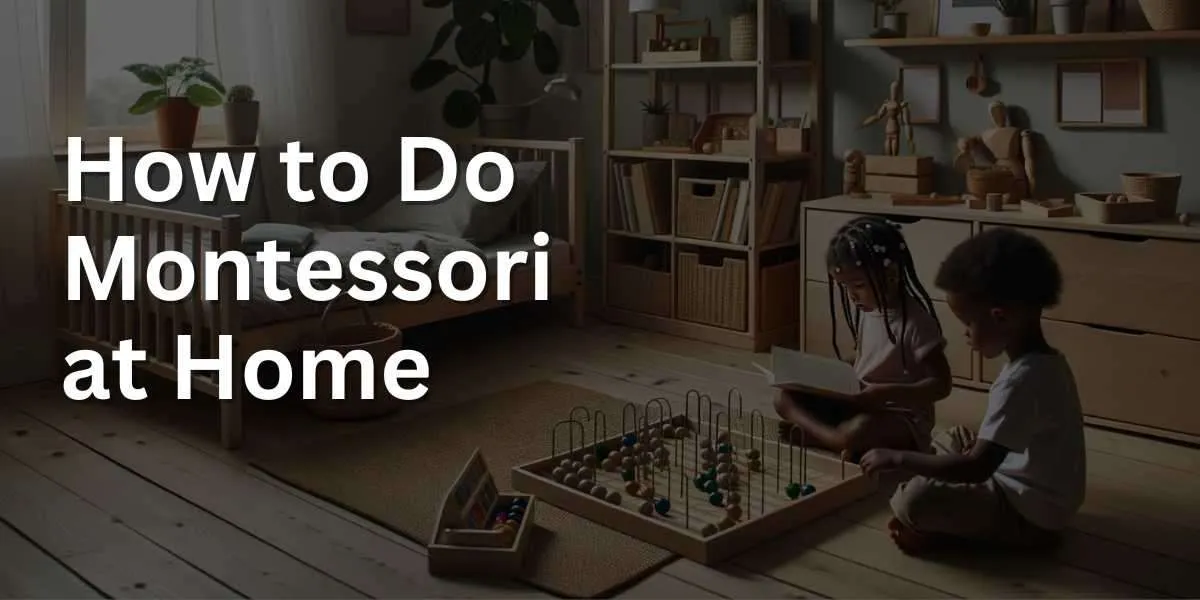Venturing into how to Montessori at home opens the door to a child-centric, exploratory learning environment. Rooted in respect for the child’s individuality, the Montessori method offers a rich approach to hands-on, experiential learning—even outside the classroom.
Successfully implementing Montessori principles at home involves creating a prepared environment, incorporating self-directed activities, and fostering autonomy. From designating child-accessible spaces to choosing age-appropriate Montessori materials, there’s a spectrum of considerations. This guide will unravel the steps to seamlessly infuse Montessori philosophy into your home, ensuring your child reaps its abundant educational benefits.
Eager to nurture your child’s natural curiosity and independence the Montessori way? Join us as we chart a path to creating a holistic Montessori-inspired environment right in your living space
Adopting Montessori principles at home doesn’t require a complete overhaul of your living space or lifestyle. It’s about creating a child-centered environment that values independence, respect, and natural learning. Remember, it’s a journey, and even small changes can have a profound impact on your child’s development.
Key Takeaways: How to Montessori at Home
- Prepare the Environment:
- Child-Friendly Spaces: Create spaces that are accessible to your child, like low shelves with toys and materials they can reach and choose from.
- Order and Simplicity: Organize materials and toys so each item has its place. This fosters a sense of order and helps children understand where to find and return items.
- Choose Montessori Materials:
- Hands-on Learning: Opt for toys and materials that promote hands-on exploration, like wooden puzzles, counting beads, and practical life tools.
- Avoid Overstimulation: Instead of flashy, battery-operated toys, choose simple, quality materials that serve a learning purpose.
- Promote Independence:
- Practical Life Skills: Encourage children to participate in daily tasks like setting the table, watering plants, or dressing themselves.
- Accessible Items: Keep everyday items, like clothing or dishes, within easy reach so kids can access and use them independently.
- Follow the Child:
- Observe Their Interests: Pay attention to what your child is drawn to and tailor activities to those interests.
- Allow Freedom Within Limits: Give children the freedom to choose activities, but set clear boundaries to ensure safety and respect.
- Incorporate Nature:
- Outdoor Play: Encourage regular outdoor play and exploration.
- Natural Materials: Use materials like wood, metal, glass, and fabric instead of plastic.
- Teach Grace and Courtesy:
- Model Behavior: Show children how to interact respectfully with others through your actions.
- Role-Playing: Engage in role-playing scenarios to teach manners, sharing, and empathy.
- Limit Interruptions:
- Respect Concentration: If a child is deeply engaged in an activity, avoid interrupting them. This fosters deep concentration and respect for their work.
- Encourage Critical Thinking:
- Ask Open-Ended Questions: Instead of direct answers, pose questions that make them think and explore concepts deeply.
- Mistakes as Learning Opportunities: Rather than correcting them immediately, allow children to learn from their mistakes.
- Establish Routines:
- Consistency: Children thrive on routine. Establishing consistent daily routines helps them know what to expect and creates a sense of security.
- Continued Learning:
- Educate Yourself: Read books, attend workshops, or join Montessori communities online to better understand and implement the philosophy.
1. Understand Montessori Principles
Principle of Independence: At the heart of Montessori at home is the idea of nurturing a child’s independence. This involves allowing children to make choices and carry out tasks on their own. It’s essential because it builds self-confidence and self-reliance, stemming from Maria Montessori’s belief that children learn best when they’re self-directed.
Prepared Environment: A cornerstone of the Montessori approach is creating an environment tailored for the child. This means organizing spaces to be engaging, accessible, and child-centric. It serves the purpose of offering a setting where children can explore and learn at their pace. The importance of this setup is to foster independent exploration and self-directed learning.
Hands-on Learning: The Montessori method emphasizes learning through touch and experience. This involves using Montessori-specific materials that prompt children to use their senses. The aim is to solidify learning through active interaction, reflecting the Montessori perspective that tangible experiences enhance concept absorption.
Follow the Child: Observing and adapting to the child’s interests is key. This approach promotes flexibility in teaching, aligning with the child’s innate curiosity. The underlying idea is that children are naturally curious, and this curiosity should be the driving force behind their learning journey.
Respect for the Child: Central to the Montessori method is the respect given to each child as an individual learner. This means adopting a non-punitive approach to discipline and emphasizing understanding and communication. This approach seeks to establish a bond of mutual respect between the child and adult, ensuring a positive and effective learning environment.
2. Organize the Home Environment for Montessori
- Shelves at child’s height: Use open shelves where toys and materials are easily reachable.
- Limit items: Avoid clutter by rotating toys and keeping only what’s relevant to the child’s current interests.
- Natural materials: Opt for wooden toys, woolen fabrics, and other natural materials over plastic.
Organizing a home environment with the Montessori approach involves creating spaces that foster independence, exploration, and learning for children. Central to this is the principle of accessibility: furniture, toys, and materials should be within easy reach of the child, preferably on low shelves or in open containers. This encourages self-directed activity and choice. The items should be curated and rotated regularly based on the child’s interests and developmental needs.
Spaces are typically minimalistic, free from clutter, and have a clear purpose, be it a reading corner, art area, or practical life station. Natural materials like wood and fabric are favored over plastic, as they offer rich sensory experiences. Every item has its own designated spot, teaching the child order and responsibility.
Real, child-sized tools and utensils are provided to instill a sense of capability and encourage participation in daily chores. By adhering to these Montessori principles, the home becomes a nurturing environment where children can thrive, develop autonomy, and engage meaningfully with their surroundings.
3. Do Montessori Practical Life Activities
- Daily chores: Involve children in household tasks like sweeping, watering plants, or setting the table.
- Self-care: Teach skills such as dressing, brushing hair, or washing hands independently.
- Food preparation: Allow kids to help in the kitchen, such as pouring, mixing, or chopping (with supervision).
Practical life activities in the Montessori approach focus on developing real-world skills that foster independence and coordination. At home, these activities can be seamlessly integrated into daily routines. Pouring and transferring exercises, for instance, can be introduced by allowing the child to pour their own drink or transfer grains from one container to another.
Dressing frames, which help children learn to button, zip, and tie, can be replicated by encouraging them to dress themselves each day. Food preparation tasks, such as peeling fruits, spreading butter, or cutting soft vegetables, not only teach fine motor skills but also instill a sense of accomplishment and contribute to family life.
Cleaning up after play, setting the table, or caring for plants are other excellent practical life activities that emphasize responsibility and order. By engaging in these hands-on tasks, children not only learn essential life skills but also develop concentration, coordination, and a sense of purpose.
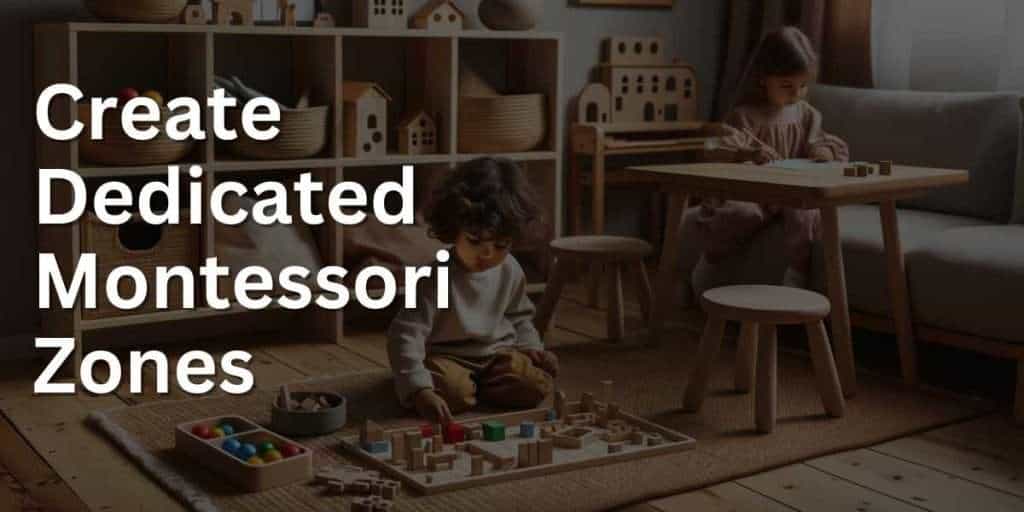
4. Create Dedicated Montessori Zones
- Activity zone: A space for art, puzzles, or other Montessori materials.
- Quiet zone: A comfortable reading nook or a place for relaxation.
- Nature zone: A spot for plants, nature materials, or a small aquarium to connect with nature.
Creating dedicated Montessori zones at home is essential for fostering an environment conducive to child-led learning and exploration. These zones, tailored to the child’s interests and developmental stage, provide organized, accessible spaces filled with purposeful, age-appropriate materials.
A reading nook, for instance, can be set up with a comfortable chair, low shelves, and a selection of curated books, encouraging a love for reading. A practical life station, equipped with child-sized tools and utensils, allows for hands-on activities like cooking, cleaning, and gardening. The sensorial zone can be filled with materials that stimulate the senses, such as texture boards, scent jars, and sound cylinders.
By allocating specific areas for activities like art, science, and math, children can independently choose what they want to explore, promoting autonomy, concentration, and order. These zones, free from distractions and clutter, become the cornerstone of the Montessori-at-home experience, ensuring holistic development and engagement.
5. Include Montessori Sensorial Materials
- Texture exploration: Fabric swatches, sandpaper, or sensory bins.
- Sound: Musical instruments, sound matching games, or listening to nature sounds.
- Visual: Color sorting games, light tables, or pattern activities.
Incorporating Montessori sensorial materials in the home environment plays a pivotal role in enhancing a child’s sensory perception and cognitive development. These materials, meticulously crafted to stimulate one or more of the five senses, offer hands-on experiences that foster discrimination, order, and refinement of the senses.
Classic Montessori tools like the pink tower, which focuses on size differentiation, or the sound cylinders that hone auditory discrimination, are foundational in this category. Color tablets introduce color variations, while sandpaper letters provide tactile experiences linked with literacy skills. These tools not only offer a multisensory approach to learning but also aid in developing concentration, coordination, and independence.
By including these sensorial materials at home, parents pave the way for a richer, more engaging Montessori experience, allowing children to explore and understand their world in greater depth.
6. Montessori at Home Promotes Independence
- Accessible storage: Store clothes, dishes, or personal items where children can access them without help.
- Step stools: Place them near sinks or high shelves so children can reach independently.
Embracing the Montessori philosophy at home significantly fosters a child’s sense of independence and self-reliance. By setting up an environment that’s both child-friendly and inviting, children are naturally encouraged to explore, choose, and engage with activities at their own pace.
Essential Montessori elements, such as low shelves with accessible materials, child-sized furniture, and practical life activities, empower children to take charge of their learning journey. Whether it’s pouring their own drink, dressing themselves, or selecting a book to read, these everyday tasks become opportunities for self-directed learning.
This approach not only nurtures a strong sense of autonomy but also cultivates foundational life skills, confidence, and a genuine love for learning. The beauty of Montessori at home is its holistic approach, where the environment acts as the third teacher, guiding children towards becoming capable and responsible individuals.
7. Montessori at Home Limits Screen Time
- Focus on hands-on, tangible activities over digital screens.
- If screens are used, choose educational content and set clear boundaries.
Implementing Montessori principles at home often leads to a reduction in screen time for children. The Montessori approach emphasizes hands-on, tangible learning experiences that engage a child’s senses and promote cognitive development. As opposed to passive consumption on screens, Montessori environments offer children a plethora of real-world, tactile materials to explore, from wooden puzzles to sensory bins.
This natural interaction stimulates curiosity, creativity, and problem-solving skills. Moreover, Montessori values the importance of uninterrupted play and concentration, which screens can often disrupt.
By fostering a home environment rich in meaningful activities and opportunities for exploration, parents can easily divert attention away from screens and towards more constructive and immersive learning experiences. In doing so, children are not just kept away from screens but are also provided with beneficial alternatives that cater to their innate desire to learn and discover.
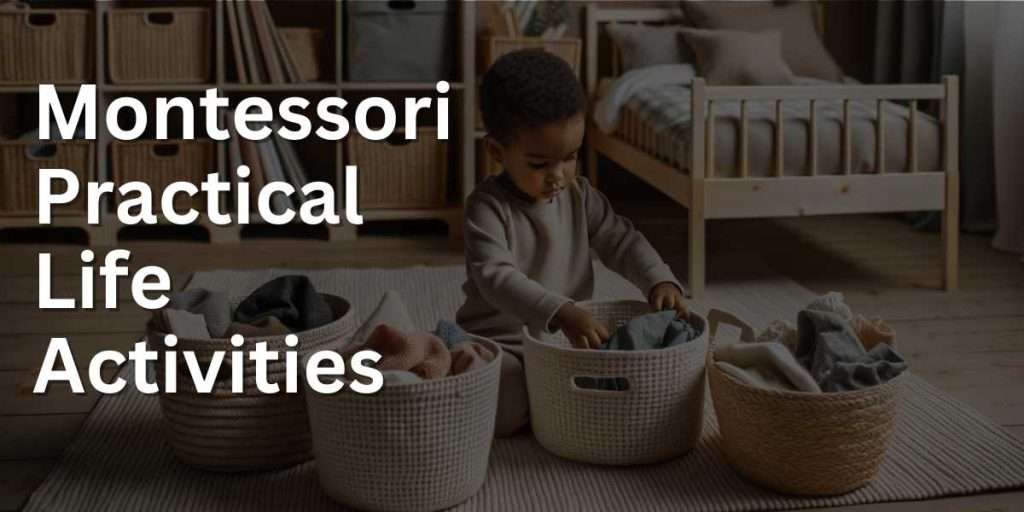
8. Montessori at Home Observes and Adapts
- Observe your child’s interests and adjust the environment or activities accordingly.
- Avoid interrupting their concentration when they’re deeply engaged in an activity.
The core essence of Montessori at home is rooted in the principle of observation and adaptation. Montessori educators and parents are trained to be keen observers, watching children as they interact with their environment and learning materials. This observation is not passive; it provides vital insights into the child’s interests, strengths, and areas needing support.
By understanding a child’s unique developmental trajectory, parents can tailor the home environment to suit their evolving needs. This might mean introducing new materials, removing items that are no longer engaging, or adjusting the physical space to foster greater independence. The ability to adapt based on observation ensures that the child remains at the center of the learning experience.
This dynamic approach not only respects the individuality of each child but also empowers them, ensuring that their environment is always aligned with their current developmental stage and interests, promoting optimal growth and learning.
9. Montessori at Home Encourages Outdoor Play
- Nature walks: Explore local parks, forests, or beaches.
- Gardening: Plant flowers, vegetables, or herbs together.
- Outdoor sensorial play: Mud kitchens, water tables, or sand play.
Montessori at home places a significant emphasis on the value of outdoor play. Recognizing the natural curiosity and boundless energy of children, the Montessori approach encourages them to explore the world outside, tapping into nature’s vast classroom. The great outdoors provides a plethora of sensory experiences, from feeling the texture of sand and soil to listening to the symphony of birds and rustling leaves.
These experiences not only enhance sensory development but also foster a deep appreciation for nature. Engaging with the natural world also bolsters a child’s physical development, coordination, and balance, as they climb, run, and navigate different terrains. Outdoor play stimulates imaginative play, problem-solving, and social interactions, as children often collaborate and negotiate roles in their games.
By incorporating outdoor play into daily routines, Montessori at home ensures that children have a holistic educational experience that values the mind, body, and spirit.
10. Montessori at Home Models Respect and Gratitude
- Show gratitude in daily life and teach children to appreciate what they have.
- Model respectful behavior, listening actively, and communicating gently.
Montessori at home embodies the principles of respect and gratitude at its core. These values are not just taught as abstract concepts but are woven into daily interactions and routines. Children are encouraged to treat others, both adults and peers, with respect, mirroring the respect they receive from their caregivers and educators. This mutual respect fosters a nurturing environment where children feel valued and understood.
Montessori at home places a strong emphasis on gratitude, teaching children to appreciate the simple joys of life and to express thankfulness for both big and small gestures. Whether it’s thanking someone for passing a tool or expressing appreciation for a meal, these practices instill a deep sense of gratitude in children.
By modeling these behaviors consistently, caregivers ensure that respect and gratitude become ingrained values in children, guiding them in their interactions and relationships throughout life.
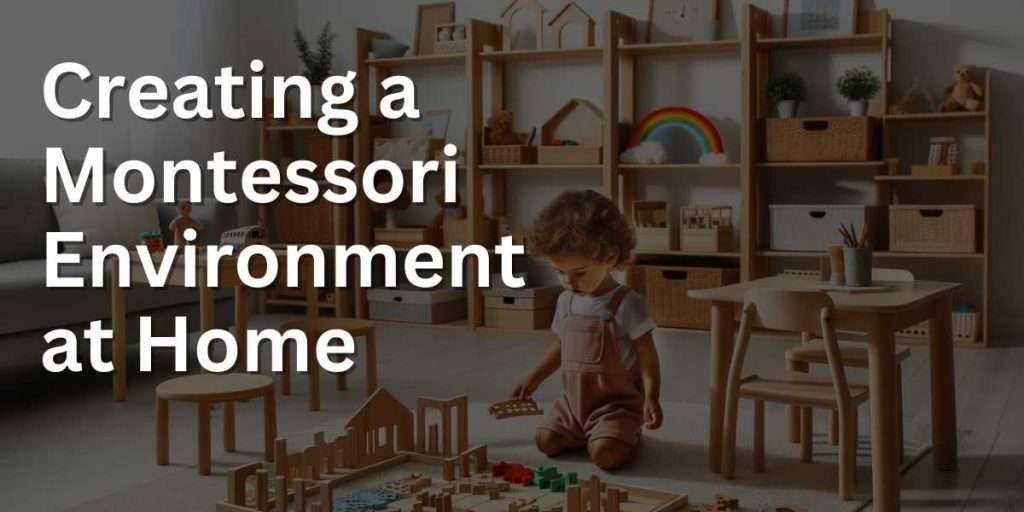
Creating a Montessori Environment at Home
It is important to start by setting up a space that is child-friendly, minimalist, and conducive to learning from the bedroom through to the playroom.
Creating A Montessori Bedroom
The Montessori child’s bedroom is designed to be a safe and comfortable space for your child to sleep and play. A floor bed is a common feature of a Montessori bedroom, as it allows your child to move freely and independently. Make sure the bed is low to the ground and has a firm mattress. You can also use a bed rail to prevent your child from rolling out of bed.
The Montessori bedroom should have low shelves or drawers that are easily accessible to your child. This will allow them to choose their own clothes and dress themselves. You can also include a mirror at their level so they can see themselves and practice self-care skills.
Creating A Montessori Playroom
The Montessori playroom is a space where your child can explore and learn through play. It should be a well-organized space with plenty of open floor space. Keep decorations to a minimum to avoid overstimulation in the montessori learning area. You can use low shelves to store learning materials and wooden toys suitable for your child’s education. Make sure the toys are age-appropriate and encourage exploration and creativity.
When setting up the Montessori playroom for your child’s montessori education, consider the layout of the room. Place the shelves and toys in a way that allows your child to move freely and independently. You can also include a table and chairs for your child to work on art projects or other activities, as well as a montessori weaning table, all should be child sized furniture.
Montessori Weaning Table and Chair Set
The Montessori Weaning Table and Chair set is a fantastic investment for parents seeking to create an enriching environment for their young toddlers. This real hardwood furniture set stands out with its versatility, doubling up as an activity cube, step stool, and reading desk, making it a central fixture in your child’s playroom.
- Real Hardwood: The Montessori Weaning Table and Chair set is crafted from real hardwood, which guarantees durability and a premium feel that’s rare in many other child-sized furniture pieces.
- Versatility: Not just a weaning table, this set doubles as a desk for toddler reading, a step stool, and an activity cube, making it a versatile addition to any playroom.
- Designed for Montessori Learning: The design is aligned with Montessori principles, promoting independence and facilitating a variety of activities for children aged 1-3.
Montessori Materials and Toys
Montessori materials and toys are an important part of the Montessori environment and a montessori parent. Montessori schools have equipment made of natural materials and encourage hands-on learning, appropriate for younger children. Some common Montessori materials include puzzles, stacking toys, art supplies and shape sorters. You can also include practical life materials such as child-sized brooms, dustpans, and kitchen tools.
When choosing Montessori materials and toys, consider your child’s age and interests. You don’t need to buy everything at once. Start with a few basic materials and add to your collection over time, as your children become school aged children you can add more equipment that is suitable. You can also rotate the toys to keep your child engaged and interested.
In terms of toy storage, use baskets or open shelves to make it easy for your child to access and put away their toys. Avoid using toy boxes with lids, as they can be difficult for young children to open and close and doesn’t tie in with implementing montessori principles.
Creating a Montessori school environment at home takes time and effort, but it can be a rewarding experience for both you and your child. By setting up a child-friendly, minimalist space with learning materials and toys, you can help your child develop independence, creativity, and a love of learning.
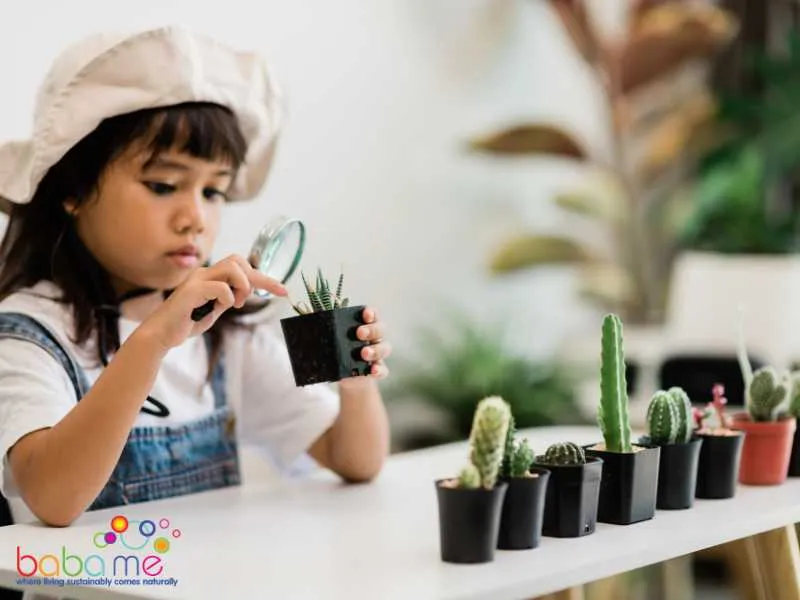
Montessori Practical Life Activities – Fostering Independence and Responsibility
As a parent, you want to raise an independent and responsible child. The Montessori approach emphasizes practical life activities that promote independence and real-life skills. Here are some ways to foster independence and responsibility at home:
Practical Life Activities
Practical life activities are simple, everyday tasks that children can do to develop their inner motivation and self-confidence. These activities include pouring, spooning, sweeping, and washing dishes. You can create a practical life area in your home with child-sized materials and tools. Step stools, learning towers, and Pikler triangles are great additions to this area.
Modeling and Encouraging Independence
Children learn by observing and imitating adults. Modeling independence and self-reliance is crucial in promoting these values in your child. Encourage your child to do things on their own, such as getting dressed, brushing their teeth, and preparing snacks. Provide them with opportunities to make choices and solve problems independently.
Inviting Participation and Responsibility
Inviting your child to participate in household chores and responsibilities is a great way to foster independence and responsibility. Assign age-appropriate tasks such as setting the table, folding laundry, and watering plants. Give them the tools and guidance they need to complete the task successfully. Praising their efforts and progress will encourage them to take on more responsibilities.
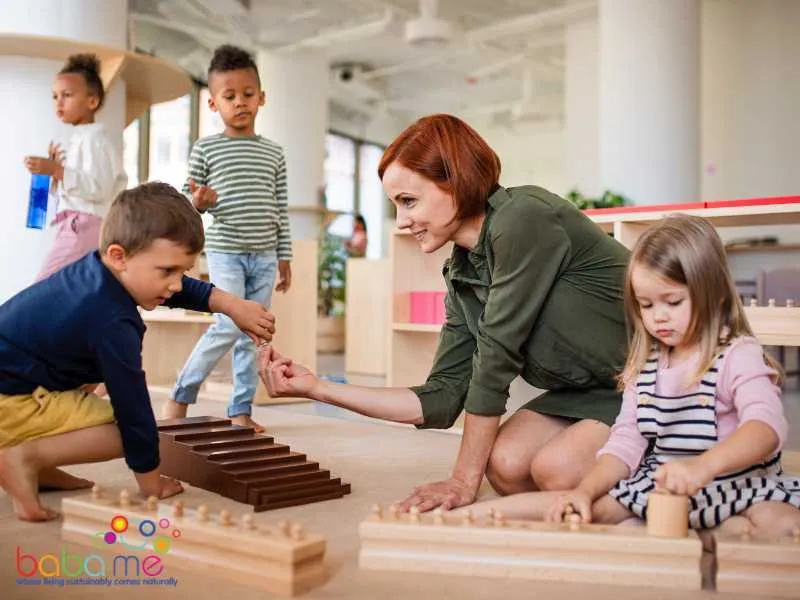
Create Dedicated Montessori Zones
In a Montessori-inspired environment, it’s essential to have well-defined spaces that cater to a child’s varied needs and interests. By creating dedicated zones, children can easily navigate and choose activities that align with their current interests, fostering independence and self-directed learning. Here are three zones that can be incorporated:
1. Activity Zone
This zone is the heart of hands-on learning. It should be equipped with a variety of Montessori materials, from art supplies for creative expression to puzzles that challenge cognitive skills. The activity zone encourages exploration, experimentation, and engagement, allowing children to immerse themselves in tasks that enhance their motor skills and problem-solving abilities.
2. Quiet Zone
Every child needs a space to unwind and reflect. The quiet zone offers just that. Whether it’s a cozy reading nook filled with age-appropriate books or a comfortable corner with soft cushions for relaxation, this zone provides a sanctuary from the bustling activities, promoting mindfulness and tranquility.
3. Nature Zone
Connecting with nature is a fundamental Montessori principle. The nature zone can be a dedicated spot for plants, fostering responsibility as children care for them. It can also house nature materials like rocks, shells, or even a small aquarium. This zone nurtures a child’s innate curiosity about the natural world, instilling respect and appreciation for life in all its forms.
Incorporating these zones in a Montessori space ensures a holistic environment that caters to a child’s cognitive, emotional, and sensory needs.
Montessori Observing and Following the Child
Observing and following the child is at the core of Montessori philosophy. It is a way of understanding the child’s needs, interests, and abilities. By observing and following the child, you can create an environment that supports their natural development. In this section, we will explore the importance of observing and following the child, and how you can do it at home.
The Absorbent Mind
Maria Montessori believed that children have an absorbent mind that is capable of learning and absorbing information effortlessly. The absorbent mind is most active during the first six years of a child’s life. During this time, children are like sponges, soaking up everything around them. By observing the child, you can provide an environment that is rich in experiences and opportunities for learning.
Observation in Montessori Practice
Observation is a critical component of Montessori practice. It involves watching the child to understand their needs, interests, and abilities. By observing the child, you can identify areas where they need support and areas where they are thriving. Observation is not just about watching the child; it is about being present and engaged with them.
Here are some tips for observing your child:
Observe without judgment: Try to observe without any preconceived notions or biases.
Be present: Give your full attention to your child when you are observing them.
Take notes: Write down what you observe so that you can refer back to it later.
Use all your senses: Observe not just what your child is doing but also how they are doing it.
Following the Child’s Interests
Montessori philosophy emphasizes following the child’s interests. When you follow the child’s interests, you are providing them with opportunities to learn and grow in areas that are meaningful to them. Following the child’s interests also helps to keep them engaged and motivated.
Here are some tips for following your child’s interests:
Provide a variety of materials: Offer a variety of materials and activities that align with your child’s interests.
Observe: Observe your child to see what they are naturally drawn to.
Follow up: When your child shows an interest in something, follow up with more opportunities for learning and exploration.
By observing and following the child, you can create a home environment that supports their natural development. Remember to observe without judgment, be present, take notes, use all your senses, provide a variety of materials, observe your child’s interests, and follow up.
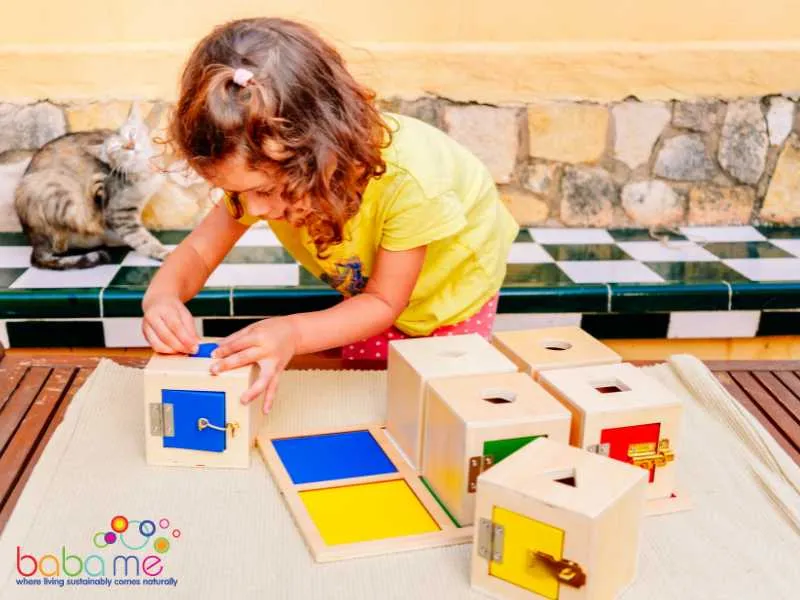
Montessori for Different Ages
Montessori education is designed to cater to the needs of children of different ages. In this section, we will explore how you can implement Montessori principles for preschoolers, school-age children, and teenagers.
Montessori for Preschoolers
Preschoolers are in the sensitive period for developing their motor skills, language, and social skills. Montessori classrooms for preschoolers have a prepared environment that is child-sized and child-friendly. You can create a similar environment at home by providing age-appropriate toys and activities that promote independence and exploration.
Some Montessori activities for preschoolers include:
Sorting and matching activities
Pouring and transferring activities
Practical life activities like sweeping and washing dishes
Sensorial activities like exploring different textures and colors
Montessori for School-Age Children
Montessori education for school-age children is focused on developing their independence, responsibility, and critical thinking skills. Montessori classrooms for school-age children have a prepared environment that is organized and structured, but also allows for creativity and exploration.
At home, you can encourage your school-age child to take responsibility for their own learning by providing them with opportunities to make their own decisions and solve problems independently. Some Montessori activities for school-age children include:
Cooking and baking activities
Gardening and nature exploration
Art and music activities
Research projects and independent study
FAQS on how to do Montessori at home
How can I do Montessori at home?
environment and providing opportunities for independent learning. Start by setting up your home environment to encourage independence – have furniture at your child’s height, keep toys and learning materials within reach, and create dedicated areas for different activities. Offer a variety of hands-on learning activities based on your child’s interests. Encourage independence by allowing your child to do tasks like dressing themselves, cleaning up toys, and helping with cooking. Remember, the goal isn’t perfection but to nurture curiosity, independence, and a love for learning.
What is Montessori theory at home?
Montessori theory at home involves applying the principles of Montessori education in the home environment. The key aspects include respect for the child’s individuality, fostering independence, providing hands-on learning experiences, and creating a prepared environment that promotes self-learning and exploration. This approach aims to foster a love for learning, build practical life skills, and nurture the child’s holistic development.
Is Montessori good for ADHD?
Yes, the Montessori method can be beneficial for children with ADHD. Montessori classrooms encourage movement, offer hands-on learning activities, and allow for individualized pace of learning – all of which can help children with ADHD. The Montessori environment can provide the structure and individualized attention that children with ADHD often need to thrive. However, each child is unique, and it’s important to consider their specific needs and challenges.
What is the best age to start Montessori at home?
There’s no “wrong” age to start implementing Montessori principles at home, as they can benefit children of all ages. However, many parents start as early as infancy. Even babies can benefit from a Montessori-inspired environment that encourages exploration and independence. The earlier you start, the more naturally these principles will be incorporated into your child’s daily routines and habits. But even if a child is older, it’s never too late to start implementing Montessori principles at home.

